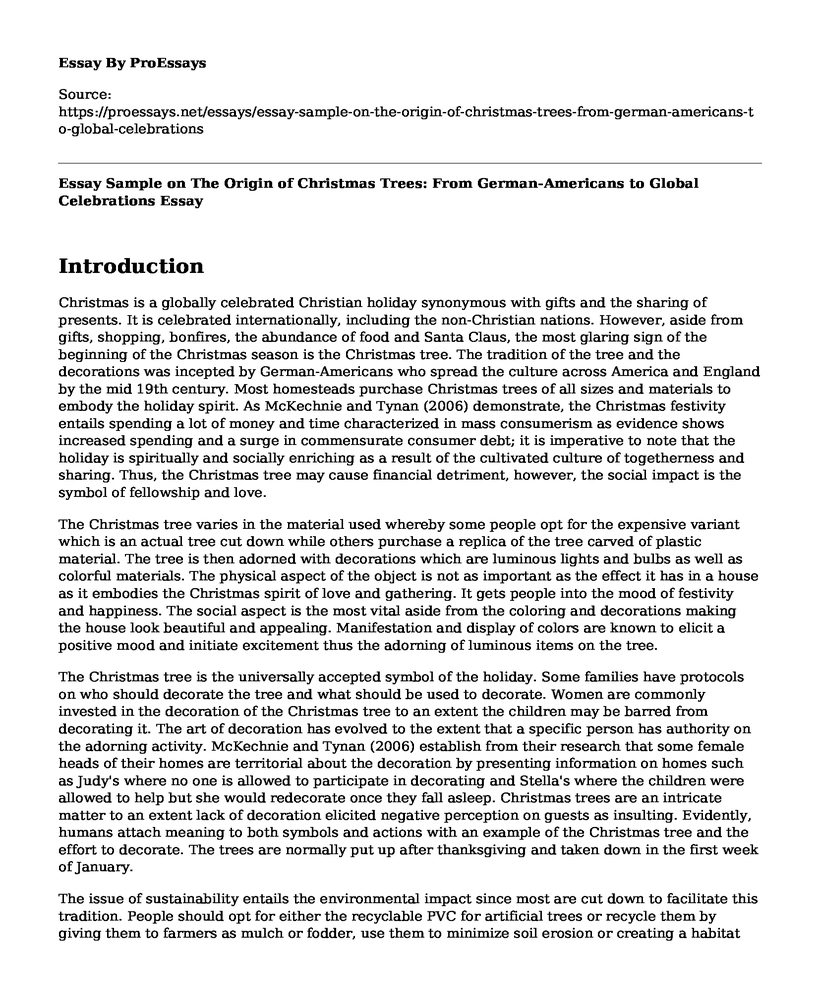Introduction
Christmas is a globally celebrated Christian holiday synonymous with gifts and the sharing of presents. It is celebrated internationally, including the non-Christian nations. However, aside from gifts, shopping, bonfires, the abundance of food and Santa Claus, the most glaring sign of the beginning of the Christmas season is the Christmas tree. The tradition of the tree and the decorations was incepted by German-Americans who spread the culture across America and England by the mid 19th century. Most homesteads purchase Christmas trees of all sizes and materials to embody the holiday spirit. As McKechnie and Tynan (2006) demonstrate, the Christmas festivity entails spending a lot of money and time characterized in mass consumerism as evidence shows increased spending and a surge in commensurate consumer debt; it is imperative to note that the holiday is spiritually and socially enriching as a result of the cultivated culture of togetherness and sharing. Thus, the Christmas tree may cause financial detriment, however, the social impact is the symbol of fellowship and love.
The Christmas tree varies in the material used whereby some people opt for the expensive variant which is an actual tree cut down while others purchase a replica of the tree carved of plastic material. The tree is then adorned with decorations which are luminous lights and bulbs as well as colorful materials. The physical aspect of the object is not as important as the effect it has in a house as it embodies the Christmas spirit of love and gathering. It gets people into the mood of festivity and happiness. The social aspect is the most vital aside from the coloring and decorations making the house look beautiful and appealing. Manifestation and display of colors are known to elicit a positive mood and initiate excitement thus the adorning of luminous items on the tree.
The Christmas tree is the universally accepted symbol of the holiday. Some families have protocols on who should decorate the tree and what should be used to decorate. Women are commonly invested in the decoration of the Christmas tree to an extent the children may be barred from decorating it. The art of decoration has evolved to the extent that a specific person has authority on the adorning activity. McKechnie and Tynan (2006) establish from their research that some female heads of their homes are territorial about the decoration by presenting information on homes such as Judy's where no one is allowed to participate in decorating and Stella's where the children were allowed to help but she would redecorate once they fall asleep. Christmas trees are an intricate matter to an extent lack of decoration elicited negative perception on guests as insulting. Evidently, humans attach meaning to both symbols and actions with an example of the Christmas tree and the effort to decorate. The trees are normally put up after thanksgiving and taken down in the first week of January.
The issue of sustainability entails the environmental impact since most are cut down to facilitate this tradition. People should opt for either the recyclable PVC for artificial trees or recycle them by giving them to farmers as mulch or fodder, use them to minimize soil erosion or creating a habitat for the wildlife.
The financial implication has seen an upsurge for the consumers of the Christmas trees. Since the inception of the tradition, the price has escalated and the purchasers have increased as homesteads do not want to be left behind in the culture. A Christmas tree in a house is a symbol of happiness and festivity and people are nostalgic about it to an extent they have little concern for their financial detriment that comes later. Therefore, the Christmas tree has embodied the holiday and given people a feeling of belonging and nostalgia and has defined the festivity globally.
Reference
McKechnie, S., & Tynan, C. (2006). Social Meanings in Christmas Consumption: An Exploratory Study of UK Celebrants' Consumption Rituals. Journal of Consumer Behaviour: An International Research Review, 5(2), 130-144. Retrieved from https://www.academia.edu/download/39488158/Social_meanings_in_Christmas_consumption20151028-28564-cr059n.pdf
Cite this page
Essay Sample on The Origin of Christmas Trees: From German-Americans to Global Celebrations. (2023, Mar 14). Retrieved from https://proessays.net/essays/essay-sample-on-the-origin-of-christmas-trees-from-german-americans-to-global-celebrations
If you are the original author of this essay and no longer wish to have it published on the ProEssays website, please click below to request its removal:
- Essay on Korean Makeup Trend
- Essay Sample on Mythology Theory in Popular Culture
- The Design of the Museum of Islamic Art Essay
- Essay Sample on Cultural Diversity: Its Impact on Leadership in Education
- Essay Example on Boston Children's Museum: Joyful Discoveries for Families
- Essay Example on Kew Gardens - Royal Botanic Gardens in London, UK
- Paper Example on Beauty Pageants: Sites for Cultural Production & Contestation







